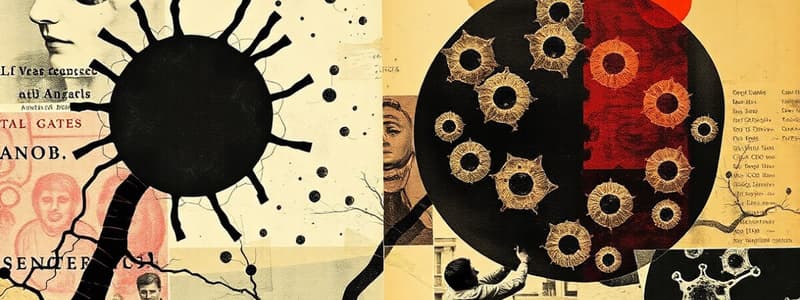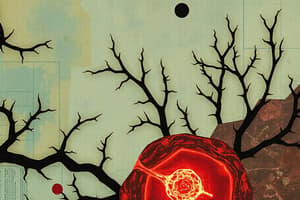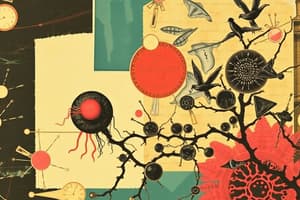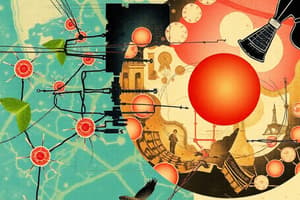Podcast
Questions and Answers
What can mutations in receptors lead to?
What can mutations in receptors lead to?
- Decreased cell growth
- Consistent active signaling causing cell growth (correct)
- Improved receptor sensitivity
- Increased apoptosis
What are proto-oncogenes responsible for in the body?
What are proto-oncogenes responsible for in the body?
- Inhibiting cell division
- Encoding normal growth factor genes (correct)
- Preventing gene expression
- Encouraging normal cell death
What results from a mutation in the RAS proto-oncogene?
What results from a mutation in the RAS proto-oncogene?
- Reduced cell proliferation
- Uncontrolled cell growth (correct)
- Increased cell apoptosis
- Improved signal transduction
Which process serves as an indication of cancer regarding ABL mutations?
Which process serves as an indication of cancer regarding ABL mutations?
What is the consequence of dysregulation of the MYC protein?
What is the consequence of dysregulation of the MYC protein?
What role do cell-cycle dependent kinases (CDKs) play?
What role do cell-cycle dependent kinases (CDKs) play?
What do oncoproteins arise from?
What do oncoproteins arise from?
What is the effect of ABL-BCP hybrid regarding RAS?
What is the effect of ABL-BCP hybrid regarding RAS?
How is the MYC protein related to tumor development?
How is the MYC protein related to tumor development?
What role does RAS play in normal cell growth?
What role does RAS play in normal cell growth?
What do the Hallmarks of cancer represent?
What do the Hallmarks of cancer represent?
Which hallmark of cancer refers to a cell's ability to avoid the process of programmed cell death?
Which hallmark of cancer refers to a cell's ability to avoid the process of programmed cell death?
What do self-sufficient cancer cells do with growth signals?
What do self-sufficient cancer cells do with growth signals?
Which of the following is NOT considered one of the Hallmarks of cancer?
Which of the following is NOT considered one of the Hallmarks of cancer?
How do cancer cells manipulate the surrounding stroma regarding growth factors?
How do cancer cells manipulate the surrounding stroma regarding growth factors?
What is the significance of over-expressed growth factor receptors in cancer cells?
What is the significance of over-expressed growth factor receptors in cancer cells?
Which factor enables many of the hallmarks of cancer, providing a backdrop for cancer development?
Which factor enables many of the hallmarks of cancer, providing a backdrop for cancer development?
What hallmark allows cancer cells to grow without limitation?
What hallmark allows cancer cells to grow without limitation?
What is a common effect of tumor-promoting inflammation in cancer?
What is a common effect of tumor-promoting inflammation in cancer?
Which hallmark involves the ability of cancer cells to spread to other parts of the body?
Which hallmark involves the ability of cancer cells to spread to other parts of the body?
Flashcards
Hallmarks of Cancer
Hallmarks of Cancer
Eight fundamental physiological changes that normal cells undergo to become cancerous.
Self-sufficiency in growth signals
Self-sufficiency in growth signals
Cancer cells can produce and respond to their own growth signals, bypassing normal controls.
Growth Factors
Growth Factors
Substances that stimulate cell growth and division.
Growth Factor Receptors
Growth Factor Receptors
Signup and view all the flashcards
Over-expression (growth factor receptors)
Over-expression (growth factor receptors)
Signup and view all the flashcards
Cell Proliferation
Cell Proliferation
Signup and view all the flashcards
Genetic instability
Genetic instability
Signup and view all the flashcards
Tumor promoting inflammation
Tumor promoting inflammation
Signup and view all the flashcards
Cancer cell growth factor production
Cancer cell growth factor production
Signup and view all the flashcards
Cancer cell growth factor receptor over-expression
Cancer cell growth factor receptor over-expression
Signup and view all the flashcards
Proto-oncogenes
Proto-oncogenes
Signup and view all the flashcards
Oncogenes
Oncogenes
Signup and view all the flashcards
Oncoproteins
Oncoproteins
Signup and view all the flashcards
RAS
RAS
Signup and view all the flashcards
RAS Mutation
RAS Mutation
Signup and view all the flashcards
ABL
ABL
Signup and view all the flashcards
ABL-BCP hybrid
ABL-BCP hybrid
Signup and view all the flashcards
MYC protein dysregulation
MYC protein dysregulation
Signup and view all the flashcards
Cell cycle checkpoints
Cell cycle checkpoints
Signup and view all the flashcards
Cell cycle dependent kinases (CDKs)
Cell cycle dependent kinases (CDKs)
Signup and view all the flashcards
Study Notes
Hallmarks of Cancer
- All cancers exhibit 8 fundamental physiological changes
- These are called hallmarks
- These changes allow cells to evade normal biological laws, leading to cancer
- Physiological changes in cancer cells include:
- Self-sufficiency in growth signals
- Insensitivity to growth inhibitory signals
- Evasion of apoptosis
- Limitless replicative potential (immortality)
- Sustained angiogenesis
- Invasion and metastasis
- Evasion of immune surveillance
- These hallmarks are enabled by:
- Genetic instability
- Tumor-promoting inflammation
Self-Sufficiency in Growth Factors
- Cell proliferation is part of cell division
- It involves generating more cells from existing ones to repair tissues.
- Before going into detail, the hallmark of cell proliferation relies on the expression of genes and cell division
- It is initiated by growth factors (GF)
- GF bind to receptors, triggering a cascade of events, leading to cell division.
Growth Factors and Their Receptors
- Growth Factors are proteins
- Normally, these are produced and utilized by neighboring cells.
- These are 'rules' followed by normal cells
- Cancers break these rules by either producing their own growth factors to activate their receptors. and/or over-expressing receptors
- Over-expression of receptors can lead to increased sensitivity and activation of these receptors.
- Mutations in growth factor receptors can make them permanently active, leading to continuous cell growth.
- Some cancers can modify growth factor receptors permanently, always keeping them stimulated, resulting in uncontrolled growth
Downstream Signal-Transduction Proteins
- A key step in cell proliferation involves a cascade of proteins that transmit signals from receptors.
- They work by activating other proteins in the cell, resulting in downstream events leading to cell proliferation.
- Important Downstream proteins include RAS and the RAS Pathway. Also include downstream molecules involved in cell growth.
Oncogenes and Tumor Suppressor Genes
- Proto-oncogenes, when altered, turn into oncogenes, which are constantly active, causing uncontrolled cell growth.
- Tumor suppressor genes work as brakes on cell growth regulating the cell cycle, ensuring normal cell division.
- Abnormalities in these genes contribute to cancer development.
- Alteration in these genes can lead to unregulated cell growth, resulting in cancer.
- Example of a tumor suppressor gene is PTEN
- Example of oncogene is ABL
Dysregulation of Cell Cycle
- A critical process for cell development in a cell's life cycle.
- The cell cycle comprises G1, S, G2, and M phases.
- Problems in the checkpoints of the cell cycle cause uncontrolled cell growth and accumulation of genetic mutations.
- Cell cycle dysregulation contributes significantly to cancer development.
Studying That Suits You
Use AI to generate personalized quizzes and flashcards to suit your learning preferences.



